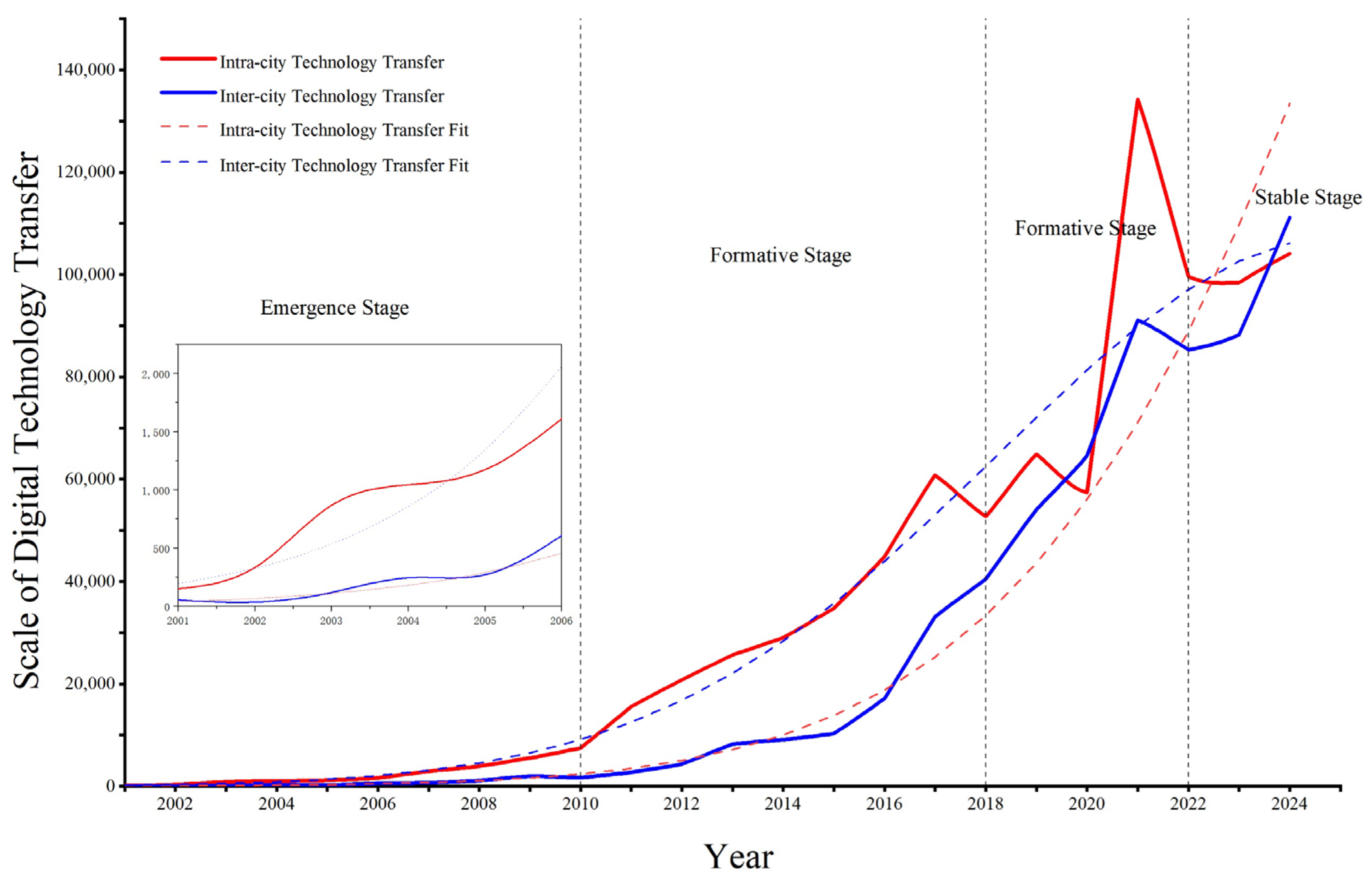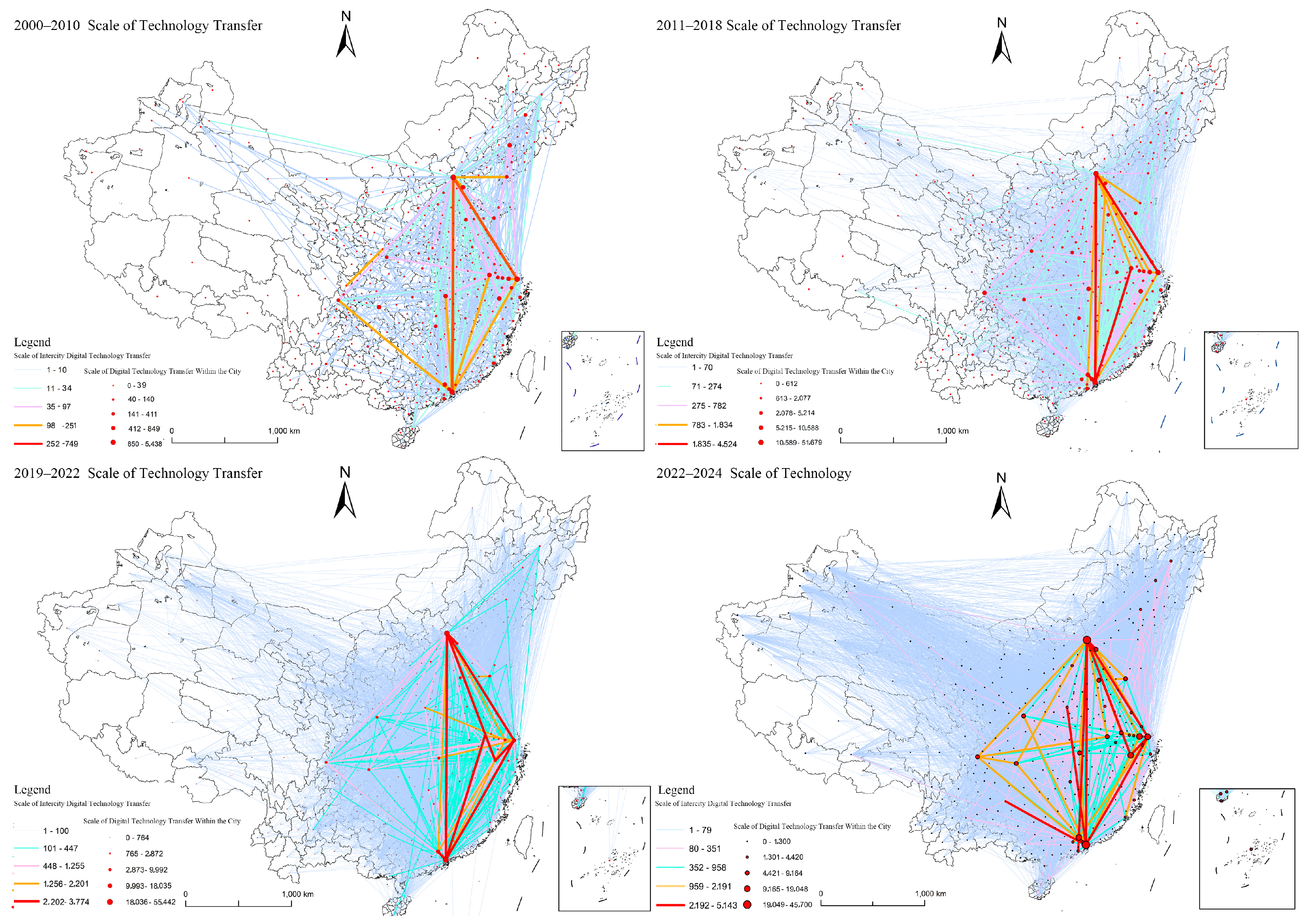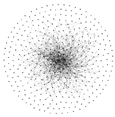Network Evolution of Digital Technology Transfers and Implications for Urban Digital Innovation Governance: Evidence from Chinese Patent Transactions
Abstract
1. Introduction
2. Theoretical Foundations and Research Hypotheses
3. Research Methods and Data Sources
3.1. Data Sources and Processing
3.1.1. Data Recognition
3.1.2. Phases of Digital Technology Transfer
3.2. Variable Specification and Econometric Model Design
3.2.1. Variable Declaration
3.2.2. Model Construction
4. Digital Technology Transfers Across Different Geographical Scales
4.1. Spatio-Temporal Evolution of Inter-City Digital Technology Transfer
4.2. Spatial-Temporal Evolution of Technology Transfer in Urban Areas
5. The Impact of Digital Technology Transfers on Urban Digital Innovation Capabilities
5.1. Baseline Regression
5.2. Stability Test
5.3. Heterogeneity Test
6. Conclusions and Discussion
6.1. Conclusions
6.2. Discussion
Author Contributions
Funding
Institutional Review Board Statement
Informed Consent Statement
Data Availability Statement
Conflicts of Interest
References
- Lee, M.; Yun, J.J.; Pyka, A.; Won, D.; Kodama, F.; Schiuma, G.; Park, H.; Jeon, J.; Park, K.; Jung, K.; et al. How to Respond to the Fourth Industrial Revolution, or the Second Information Technology Revolution? Dynamic New Combinations between Technology, Market, and Society through Open Innovation. J. Open Innov. Technol. Mark. Complex. 2018, 4, 21. [Google Scholar] [CrossRef]
- Gal, P.; Nicoletti, G.; Renault, T.; Sorbe, S.; Timiliotis, C. Digitalisation and productivity: In search of the holy grail–Firm-level empirical evidence from EU countries. In OECD Economics Department Working Papers; OECD Publishing: Paris, France, 2019; No. 1533. [Google Scholar] [CrossRef]
- McKelvey, M. Firms navigating through innovation spaces: A conceptualisation of how firms search and perceive technological, market and productive opportunities globally. J. Evol. Econ. 2016, 26, 785–802. [Google Scholar] [CrossRef] [PubMed]
- Mi, R.; Liu, S.; Liu, C.; Li, Z.; Li, S. The Nexus of Digitalization, Talent, and High-Quality Development: How Clusters Foster Sustainable Economic Growth. Sustainability 2025, 17, 8503. [Google Scholar] [CrossRef]
- Cooke, P. Regional innovation systems: Competitive regulation in the new Europe. Geoforum 1992, 23, 365–382. [Google Scholar] [CrossRef]
- Al-Omoush, K.S.; Ribeiro-Navarrete, S.; Lassala, C.; Skare, M. Networking and knowledge creation: Social capital and collaborative innovation in responding to the COVID-19 crisis. J. Innov. Knowl. 2022, 7, 100181. [Google Scholar] [CrossRef]
- Argote, L.; Guo, J.; Park, S.-S.; Hahl, O. The mechanisms and components of knowledge transfer: The virtual special issue on knowledge transfer within organizations. Organ. Sci. 2022, 33, 1232–1249. [Google Scholar] [CrossRef]
- Ezenwa, M.O.; Smith, T.B.; Richey, J.; Smith, U.D.; Stern, M.C.; Reams, R.; Wilkie, D.J. Social network analysis of the CaRE2 health equity center: Team science in full display. Clin. Transl. Sci. 2024, 17, e13747. [Google Scholar] [CrossRef]
- Li, J.; Wu, X. Research on the impact of government R&D funding on regional innovation quality: Analysis of spatial Durbin model based on 283 cities in China. Complexity 2021, 2021, 2217588. [Google Scholar] [CrossRef]
- Li, L.; Li, M.; Ma, S.; Zheng, Y.; Pan, C. Does the construction of innovative cities promote urban green innovation? J. Environ. Manag. 2022, 318, 115605. [Google Scholar] [CrossRef]
- Cao, J.; Law, S.H.; Samad, A.R.B.A.; Mohamad, W.N.B.W.; Wang, J.; Yang, X. Effect of financial development and technological innovation on green growth—Analysis based on spatial Durbin model. J. Clean. Prod. 2022, 365, 132865. [Google Scholar] [CrossRef]
- Gao, K.; Yuan, Y. Government intervention, spillover effect and urban innovation performance: Empirical evidence from national innovative city pilot policy in China. Technol. Soc. 2022, 70, 102035. [Google Scholar] [CrossRef]
- Li, Q.; Du, D.; Yu, Y. Scaling and network evolution of technology transfer in US cities. Nat. Cities 2025, 2, 316–326. [Google Scholar] [CrossRef]
- Fan, F.; Wen, Z.; Shao, X.; Zhang, H.; Yang, B. Do Technology Transfer Networks Impact Urban Innovation Capacity? Evidence From Chinese Cities. Int. Reg. Sci. Rev. 2024, 01600176241283897. [Google Scholar] [CrossRef]
- Liang, X.; Hidalgo, C.A.; Balland, P.-A.; Zheng, S.; Wang, J. Intercity connectivity and urban innovation. Comput. Environ. Urban Syst. 2024, 109, 102092. [Google Scholar] [CrossRef]
- Cai, H.; Feng, Z.; Zhou, W.; Chen, J.; Chen, Z. Understanding the spatial polarization pattern of technology transfer network in the Guangdong–Hong Kong–Macao Greater Bay area. Growth Change 2023, 54, 4–25. [Google Scholar] [CrossRef]
- Wei, L.; Zeng, B. Urban technology transfer, spatial spillover effects, and carbon emissions in China. Sustainability 2024, 16, 9662. [Google Scholar] [CrossRef]
- Edler, J.; Blind, K.; Kroll, H.; Schubert, T. Technology sovereignty as an emerging frame for innovation policy. Defining rationales, ends and means. Res. Policy 2023, 52, 104765. [Google Scholar] [CrossRef]
- Weng, Z.; Fan, F.; Yang, B.; Zhang, H. Regional differences and drivers of patent transfer-in between Chinese cities: A city absorptive capacity perspective. Technol. Anal. Strateg. Manag. 2024, 36, 4113–4127. [Google Scholar] [CrossRef]
- Lundvall, B.-A. National Systems of Innovation: Towards a Theory of Innovation and Interactive Learning; London Pinter: London, UK, 1992; Volume 242. [Google Scholar]
- Compagnucci, L.; Spigarelli, F. Improving knowledge transfer and innovation services: A roadmap for Knowledge Transfer Offices. J. Innov. Knowl. 2024, 9, 100577. [Google Scholar] [CrossRef]
- Wen, Z.; Shao, X. Do Spatial Spillovers of Technology Transfer Networks Impact Urban Innovation Capacity? Evidence from Chinese Cities. Reg. Sci. Environ. Econ. 2025, 2, 12. [Google Scholar] [CrossRef]
- Castells, M. Materials for an exploratory theory of the network society1. Br. J. Sociol. 2000, 51, 5–24. [Google Scholar] [CrossRef]
- Zhao, D.; Tang, C.; Huang, X. Innovation network, knowledge spillover, and urban green economic performance. Front. Phys. 2025, 13, 1537110. [Google Scholar] [CrossRef]
- Lu, J.; Li, H. Can digital technology innovation promote total factor energy efficiency? Firm-level evidence from China. Energy 2024, 293, 130682. [Google Scholar] [CrossRef]
- Wang, J.; Li, S.; Chen, J.; Ding, S. Study on the evolution of multi-level collaborative innovation networks in China’s cloud manufacturing industry. Technol. Anal. Strateg. Manag. 2024, 1–22. [Google Scholar] [CrossRef]
- Cohen, W.M.; Levinthal, D.A. Absorptive capacity: A new perspective on learning and innovation. Adm. Sci. Q. 1990, 35, 128–152. [Google Scholar] [CrossRef]
- Shi, X.; Sui, F.; Huang, X. Green technology transfer for firms in a multi-layer network perspective: The dual impact of knowledge resources and regional environment. Environ. Technol. Innov. 2025, 39, 104291. [Google Scholar] [CrossRef]
- Wang, H.; Liu, P. Characteristics of China’s digital economy network and its impact on carbon emissions. Front. Ecol. Evol. 2023, 11, 1243360. [Google Scholar] [CrossRef]
- Huang, J.; Liu, K. The Spatial Correlation Network of China’s Urban Digital Economy and Its Formation Mechanism. Sustainability 2025, 17, 5382. [Google Scholar] [CrossRef]
- Archibugi, D.; Filippetti, A. The retreat of public research and its adverse consequences on innovation. Technol. Forecast. Soc. Change 2018, 127, 97–111. [Google Scholar] [CrossRef]
- Grillitsch, M.; Nilsson, M. Innovation in peripheral regions: Do collaborations compensate for a lack of local knowledge spillovers? Ann. Reg. Sci. 2015, 54, 299–321. [Google Scholar] [CrossRef]
- Nambisan, S.; Wright, M.; Feldman, M. The digital transformation of innovation and entrepreneurship: Progress, challenges and key themes. Res. Policy 2019, 48, 103773. [Google Scholar] [CrossRef]


| Variable Name | Measurement | Data Source | |
|---|---|---|---|
| Dependent variable | Urban Digital Technology Innovation Capability | Digital Economy Patent Authorisations | CNRDS Database |
| Independent variables | Inter-city Digital Technology Transfer | Transfer of Digital Patent Technologies Between Prefecture-Level Cities | State Intellectual Property Office |
| Digital Technology Transfer Within the City | Digital Patent Technology Transfer Within Prefecture-Level Cities | State Intellectual Property Office | |
| Control variables | Level of economic development | GDP per capita | City Statistical Yearbook |
| Human capital | Number of Full-time Faculty Members at Regular Higher Education Institutions | City Statistical Yearbook | |
| Foundations of Higher Education | Number of employees in comprehensive scientific research technical services | City Statistical Yearbook | |
| Scientific Expenditure | City Statistical Yearbook | ||
| Share of Fixed Asset Investment | Share of Fixed Asset Investment | City Statistical Yearbook | |
| Technology R&D | Research and Development Personnel | City Statistical Yearbook |
| Emergence Stage | Formative Stage | Growth Stage | Stable Stage | |
|---|---|---|---|---|
| Visualization |  |  |  |  |
| Network Density | 0.011 | 0.093 | 0.147 | 0.225 |
| Average Degree | 3.957 | 35.788 | 54.72 | 83.575 |
| Average Weighted Degree | 35.473 | 658.827 | 1123 | 1518.054 |
| Average Clustering Coefficient | 0.573 | 0.683 | 0.703 | 0.693 |
| Average Path Length | 2.595 | 1.964 | 1.857 | 1.736 |
| Network Diameter | 6 | 4 | 3 | 3 |
| Emergence Stage | Formative Stage | Growth Stage | Stable Stage | |||||
|---|---|---|---|---|---|---|---|---|
| PageRank | Closeness | PageRank | Closeness | PageRank | Closeness | PageRank | Closeness | |
| 1 | Beijing | Beijing | Beijing | Beijing | Beijing | Beijing | Guangzhou | Guangzhou |
| 2 | Shenzhen | Shenzhen | Shenzhen | Shenzhen | Shenzhen | Shenzhen | Shenzhen | Shenzhen |
| 3 | Shanghai | Shanghai | Guangzhou | Guangzhou | Shanghai | Shanghai | Beijing | Beijing |
| 4 | Guangzhou | Guangzhou | Shanghai | Shanghai | Chengdu | Guangzhou | Shanghai | Shanghai |
| 5 | Hangzhou | Nanjing | Chengdu | Chengdu | Guangzhou | Chengdu | Suzhou | Suzhou |
| 6 | Chengdu | Hangzhou | Suzhou | Suzhou | Hangzhou | Hangzhou | Xi’an | Xi’an |
| 7 | Nanjing | Suzhou | Tianjin | Dongguan | Quanzhou | Shaoxing | Hefei | Hefei |
| 8 | Wuhan | Dongguan | Dongguan | Tianjin | Shaoxing | Suzhou | Nanjing | Chengdu |
| 9 | Suzhou | Chengdu | Quanzhou | Quanzhou | Suzhou | Quanzhou | Chengdu | Nanjing |
| 10 | Xi’an | Tianjin | Chongqing | Chongqing | Nanjing | Nanjing | Hangzhou | Hangzhou |
| 11 | Tianjin | Wuhan | Shaoxing | Shaoxing | Hefei | Hefei | Chongqing | Chongqing |
| 12 | Jinan | Wenzhou | Ningbo | Ningbo | Wuhan | Wenzhou | Wuhan | Wuhan |
| 13 | Dalian | Wuxi | Hangzhou | Hangzhou | Wenzhou | Wuhan | Tianjin | Tianjin |
| 14 | Dongguan | Changchun | Wuxi | Nanjing | Tianjin | Dongguan | Quanzhou | Jinan |
| 15 | Wenzhou | Xi’an | Nanjing | Wuxi | Xi’an | Xi’an | Jinan | Quanzhou |
| 16 | Wuxi | Shenyang | Nantong | Nantong | Dongguan | Tianjin | Wuxi | Wuxi |
| 17 | Shenyang | Changzhou | Taizhou | Taizhou | Taizhou | Taizhou | Harbin | Harbin |
| 18 | Changchun | Jinan | Wuhan | Foshan | Qingdao | Chongqing | Xuzhou | Dongguan |
| 19 | Changsha | Dalian | Foshan | Qingdao | Zhengzhou | Zhengzhou | Dongguan | Xuzhou |
| 20 | Ningbo | Ningbo | Qingdao | Wenzhou | Chongqing | Xuzhou | Foshan | Foshan |
| Emergence Stage | Formative Stage | Growth Stage | Stable Stage | |
|---|---|---|---|---|
| 1 | Beijing | Beijing | Beijing | Beijing |
| 2 | Shenzhen | Shenzhen | Shenzhen | Shenzhen |
| 3 | Shanghai | Shanghai | Guangzhou | Shanghai |
| 4 | Hangzhou | Guangzhou | Shanghai | Guangzhou |
| 5 | Guangzhou | Hangzhou | Suzhou | Hangzhou |
| 6 | Nanjing | Suzhou | Hangzhou | Suzhou |
| 7 | Suzhou | Nanjing | Nanjing | Nanjing |
| 8 | Shenyang | Chengdu | Dongguan | Wuhan |
| 9 | Wuhan | Dongguan | Jinan | Chengdu |
| 10 | Tianjin | Wuhan | Wuhan | Chongqing |
| 11 | Chongqing | Wuxi | Chengdu | Xi’an |
| 12 | Chengdu | Tianjin | Chongqing | Tianjin |
| 13 | Dongguan | Zhengzhou | Qingdao | Jinan |
| 14 | Xi’an | Chongqing | Xi’an | Hefei |
| 15 | Ningbo | Ningbo | Tianjin | Qingdao |
| 16 | Xiamen | Changzhou | Wuxi | Dongguan |
| 17 | Qingdao | Foshan | Changsha | Wuxi |
| 18 | Jiaxing | Qingdao | Nanchang | Changsha |
| 19 | Wuxi | Xi’an | Harbin | Changzhou |
| 20 | Jinan | Jinan | Hefei | Xuzhou |
| Variable | (1) | (2) |
|---|---|---|
| Intra-city Technology Transfer | 1.234 ** | |
| (3.01) | ||
| Inter-city Technology Transfer | 4.455 *** | |
| (16.41) | ||
| Time Fixed | Yes | Yes |
| City Fixed | Yes | Yes |
| Sample Size | 6153 | 6153 |
| R2 | 0.8270 | 0.8760 |
| Exclude Certain Samples | One-Period Lag | Two-Period Lag | ||||
|---|---|---|---|---|---|---|
| Variable | (1) | (2) | (3) | (4) | (5) | (6) |
| Intra-city Technology Transfer | 1.258 * | 4.036 * | 1.258 * | |||
| (2.69) | (2.23) | (2.69) | ||||
| Inter-city Technology Transfer | 4.346 *** | 5.835 *** | 4.346 *** | |||
| (11.49) | (3.85) | (11.49) | ||||
| Time Fixed | Yes | Yes | Yes | Yes | Yes | Yes |
| City Fixed | Yes | Yes | Yes | Yes | Yes | Yes |
| Sample Size | 6069 | 6069 | 6446 | 6446 | 6153 | 6153 |
| R2 | 0.7780 | 0.7793 | 0.7255 | 0.8132 | 0.6778 | 0.7708 |
| High-Level Cities | Low-Level Cities | |||
|---|---|---|---|---|
| Variable | (1) | (2) | (3) | (4) |
| Intra-city Technology Transfer | 1.258 *** | 4.036 *** | ||
| (3.50) | (3.73) | |||
| Inter-city Technology Transfer | 4.346 *** | 5.835 *** | ||
| (5.17) | (6.58) | |||
| Time Fixed | Yes | Yes | Yes | Yes |
| City Fixed | Yes | Yes | Yes | Yes |
| Sample Size | 756 | 756 | 5397 | 5397 |
| R2 | 0.8341 | 0.8846 | 0.7121 | 0.7217 |
Disclaimer/Publisher’s Note: The statements, opinions and data contained in all publications are solely those of the individual author(s) and contributor(s) and not of MDPI and/or the editor(s). MDPI and/or the editor(s) disclaim responsibility for any injury to people or property resulting from any ideas, methods, instructions or products referred to in the content. |
© 2025 by the authors. Licensee MDPI, Basel, Switzerland. This article is an open access article distributed under the terms and conditions of the Creative Commons Attribution (CC BY) license (https://creativecommons.org/licenses/by/4.0/).
Share and Cite
Wang, H.; Cui, W. Network Evolution of Digital Technology Transfers and Implications for Urban Digital Innovation Governance: Evidence from Chinese Patent Transactions. Sustainability 2025, 17, 9584. https://doi.org/10.3390/su17219584
Wang H, Cui W. Network Evolution of Digital Technology Transfers and Implications for Urban Digital Innovation Governance: Evidence from Chinese Patent Transactions. Sustainability. 2025; 17(21):9584. https://doi.org/10.3390/su17219584
Chicago/Turabian StyleWang, Haining, and Wanglai Cui. 2025. "Network Evolution of Digital Technology Transfers and Implications for Urban Digital Innovation Governance: Evidence from Chinese Patent Transactions" Sustainability 17, no. 21: 9584. https://doi.org/10.3390/su17219584
APA StyleWang, H., & Cui, W. (2025). Network Evolution of Digital Technology Transfers and Implications for Urban Digital Innovation Governance: Evidence from Chinese Patent Transactions. Sustainability, 17(21), 9584. https://doi.org/10.3390/su17219584





